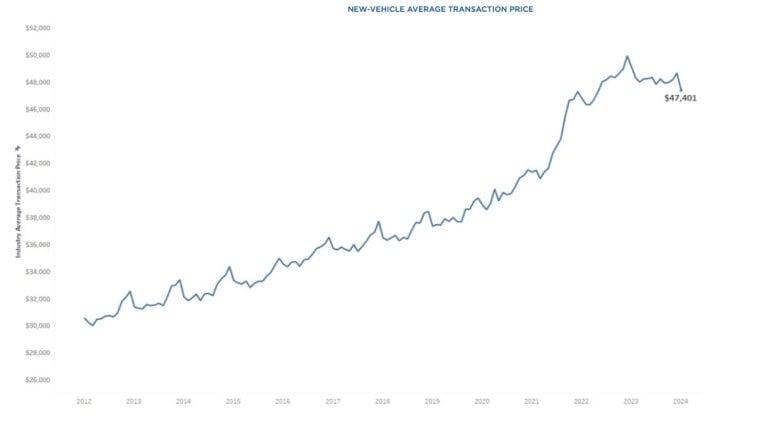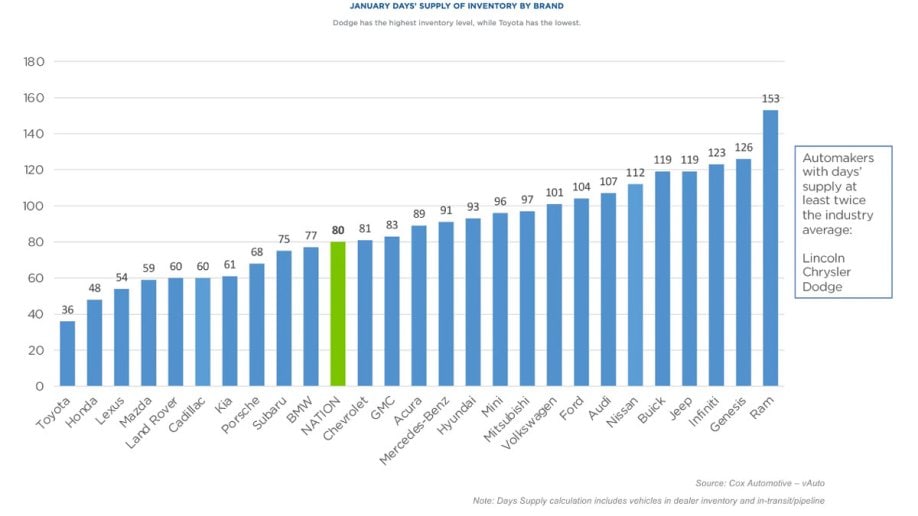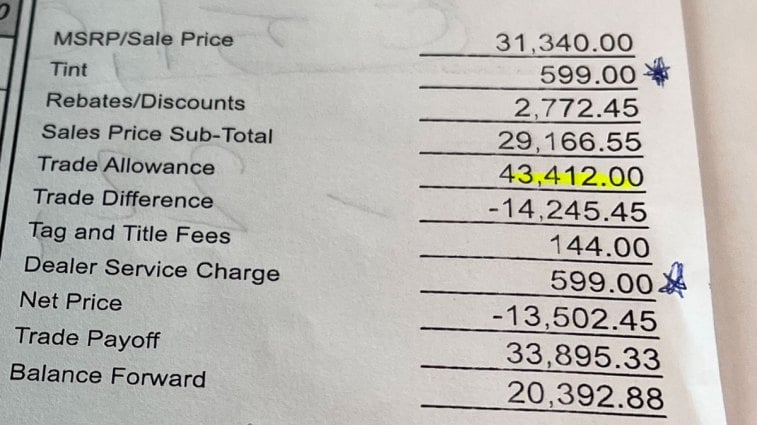When Will New Car Prices Drop?
By Renee Valdes 02/15/2024 1:42pm

Quick Facts About Car Prices
- New car prices are 3.5% lower than at the beginning of 2023.
- Still, average new car transactions were about 16% higher than the same month three years ago during the pandemic.
- Manufacturer incentives averaged about $2,700 in January.
- You can easily find a new Lincoln, Chrysler, Dodge, or Ram, though not necessarily a Toyota, Honda, Lexus, or Mazda.
New car prices began dropping in recent months and now appear to be in a free fall with plentiful dealer inventory and more buying incentives.
In the last several years, car shoppers have become accustomed to paying more than the manufacturer’s suggested retail price (MSRP). They watched car prices rise with no apparent end in sight. The situation left many shoppers scratching their heads, and the question our experts hear most is, “When will new car prices drop?”
New vehicle price inflation all but disappeared by the end of 2023. That’s great news on its face. Still, car prices have increased dramatically in the past three years. Read on for guidance if you want to purchase a vehicle. We can equip you with the best information from our experts. We dig deeper to answer concerns about car prices.
What Drives New Car Prices?

According to Kelley Blue Book data, the average transaction price (ATP) for new cars was $47,401 in January. Cox Automotive analysts calculate a 3.5% drop year-over-year as downward price pressure favors car shoppers. Cox Automotive is the parent company of Kelley Blue Book.
“It is common to see lower transaction prices and sales in January, as December typically is a hot month for luxury vehicle sales,” said Erin Keating, executive analyst for Cox Automotive. “However, the year-over-year new-vehicle ATP decline of 3.5% is notable. Prices have been trending downward for roughly six months as automakers are sweetening deals to keep the sales flowing.”
Manufacturer incentives increased to an average of $2,702 in January. More on that in a bit.
Of note, average transaction prices remain $6,500 higher than in January 2021 as the realities of the COVID-19 pandemic seemed never-ending. At that time, average transaction prices for new vehicles were 16% lower at $40,857.
Vehicle Pricing Breakdown
- Non-luxury vehicle prices: In January, car buyers paid an average transaction price of $44,052. Overall, prices dropped 2.1% year-over-year.
- Luxury vehicle prices: The average transaction price was $60,978 for luxury vehicles. Luxury vehicles make up about 20% of total vehicle sales. Luxury prices dropped by nearly 9.7% year-over-year.
- Electric vehicle prices: The average transaction for a new electric car is $55,353, down 10.8% from a year ago. The Tesla Model Y, the electric car industry’s volume leader, saw its average transaction prices drop 21% compared to January 2023.
“First and foremost, the overall narrative is unchanged – EV prices have come down significantly in the U.S. in the past year, led by price cuts at Tesla,” said Mark Strand, senior director of business intelligence at Cox Automotive. “Our newly revised EV pricing data more accurately reflects the real-world pricing of electric vehicles in the U.S. With new EVs launching into the market seemingly every month, our pricing models have to be continually updated and revised to capture a clear picture of the market.”
These factors typically affect new car prices:
- Inventory availability
- Manufacturer incentives
- Dealer discounts
- Trade-in vehicle value
All four of those factors experienced significant disruptions in the past several years.
New Car Inventory Update

Dealerships measure their stocks of new cars to sell in a measurement called “days of inventory” — how long it would take them to sell out of new vehicles at today’s sales pace if the automaker stopped building new ones. By the start of February, many brands’ inventories were 50% higher than a year ago. Some manufacturers need to heavily discount vehicles because of a glut of supply. However, a handful of carmakers, like Toyota, Honda, and Lexus, can’t fill all car orders due to a lack of inventory. Days’ supply calculations include vehicles in dealer inventory and in transit or pipeline.
Despite plentiful car inventory for most carmakers, stock issues continue for some carmakers and particular models.
According to Michelle Krebs from Cox Automotive, the new Toyota Grand Highlander had the lowest stock, followed by the Ford Maverick compact pickup. The new Chevrolet Trax, among the least expensive cars for sale in the US at $21,495 (including a $1,095 destination fee), was also at the low end of the inventory spectrum.
Which Automakers Have the Most Vehicles?
Cox Automotive’s analysis of its vAuto new car dealership management software data shows that the Lincoln, Chrysler, and Dodge brands offer days’ supply that’s well above twice the industry average. Shoppers can also find plenty of vehicles in stock from Ram, Genesis, Infiniti, and Jeep.
Toyota, Honda, and Lexus inventory levels still sit well below normal, followed by Mazda, Land Rover, Cadillac, and Kia.
Overall, the auto industry stocked 80 days’ worth of vehicles at the beginning of February. That’s considered normal by historical standards, and it’s also up 38% from a year ago. By comparison, automakers stocked an 86-day supply of vehicles during the summer of 2019.
Vehicle Incentives Hold Steady
Carmakers used more incentives to attract buyers last month than at any point in the past two years. According to Kelley Blue Book’s analysts, carmakers spent 5.7% of the average transaction price on incentives meant to move vehicles. Incentives averaged about $2,702. Still, that figure is low compared to fall 2020, when incentive levels were about 20% of the average transaction price.
When automakers build up an oversupply of cars, they discount the vehicles to get them off dealer lots. For several years, carmakers and dealerships showed no glut of vehicles to sell, and they barely offered discounts. Now, supply is bulking up again, partly because of higher interest rates on car loans.
According to our analysis, the luxury car segment offered the biggest incentives through much of last year. In January, luxury brand incentives, including for electric cars, topped 6%.
Manufacturers offered the most incentives on electric cars. These inducements to buy have jumped more than three-fold in the past year.
Shop Around for the Best Offer on Your Trade-In
Trade-in value is another factor driving car prices. A lack of used vehicle stock is pushing used car prices higher, giving credence to the idea that buying a new vehicle is cheaper than purchasing a recent model used one. As a result, it’s a great time to trade in your car. Automakers scaled back production for several years after the 2008 recession, leaving the higher-mileage, older cars dealers sell for less than $20,000 hard to find now.
Dealers value your trade-in partly based on what they need in stock. They’re more likely to offer an excellent deal to buyers on a car fewer people are looking for currently. Car dealers are oversupplied with relatively expensive used cars.
In other words, a consumer trading in a 2018 Honda Civic will be much happier with the trade-in appraisal than one trading in a 2021 Jeep Grand Cherokee.
Shoppers should also be prepared to shop their trade-in around. It’s slightly more complicated to pull off, but selling your old car to one dealership and buying your new car from a different one may make sense if the final invoice numbers work out in your favor. Use the Kelley Blue Book Instant Cash Offer tool to shop your trade-in vehicle at nearby dealerships. When you let the deals come to you, you can select the best trade-in offer for your situation.
New Car Prices Continue to Drop
The new car landscape is a buyer’s market. Shoppers heading out to purchase a new vehicle will find many incentives to help lower the price.
For some brands and dealerships like Toyota, Honda, and Lexus, shoppers must be prepared to hunt and pay more for tougher-to-find models.
Toyota executives recently told the Cox Automotive Industry Insights team that its Toyota and Lexus brands are both running too lean, closing 2023 at about 13 days’ supply, by their measure.
Some Vehicles Still Sell at Markup Prices
While some carmakers and dealers with plenty of inventory provide incentives, others in short supply have some dealerships still marking up prices.
According to Markups.org, some Honda, Toyota, and Kia models sell above MSRP in California, North Carolina, and Pennsylvania. In Georgia, a Hyundai Tucson was recently seen with markups at a dealership in the Atlanta area.

PRO TIP: Since shopping recently for a vehicle, I found markups varied at dealerships that sold vehicles such as Kia and Hyundai. One dealer charged $599, and another $699. Another called them “doc fees.” Before you shop, understand how much those document filing fees cost for car tax, tag, and title in your state before you buy a vehicle. Those are pure markups or profit centers for the dealership. Another markup on an invoice may say “paint and fabric protection” or “window tint.” Before you sign anything, it’s wise to ask the salesperson to remove those fees if they want to sell you the car.
What to Expect: Looking Ahead
But what if you desperately want a popular car that’s in low supply? Then, it’s time to test your patience. Last year’s Federal Reserve interest rate hikes were aimed to rein in inflation but still make it hard for many consumers to afford cars. According to Cox Automotive research, the typical new car loan interest rate declined in January to an average of 9.7%. That’s down from about 10% in October. Vehicle affordability is improving, but the second half of 2024 will look better for car shoppers. Additionally, any interest rate cut could help affordability.
For now, car shoppers must remain flexible and look for deals. The best deal may not be for the car you thought you would buy.
Editor’s Note: This article has been updated for accuracy since it was initially published. Sean Tucker contributed to this report.
